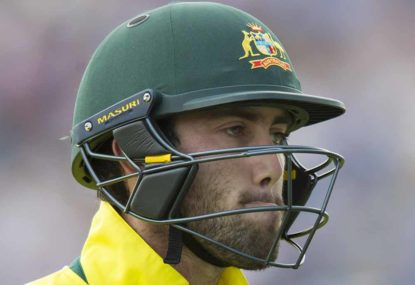Australia’s ODI side suddenly has a wobbly middle order due to the form slump of Glenn Maxwell, the continued struggles of wicketkeeper Matthew Wade, and the dumping of number eight James Faulkner.
They are more reliant on their top four than they have been in a long time, as we saw on Tuesday when they were rolled for a dismal 142, chasing only 190 against South Africa in the Caribbean.
Underrated opener Aaron Finch, who is routinely criticised by summer cricket fans, played a lone hand in that chase, keeping them in the contest with a patient 72 on yet another raging turner of a pitch.
It was the South African pacemen who set Australia on their heels, dismissing David Warner, Usman Khawaja and Steve Smith cheaply to leave them reeling at 3-21 after 7.5 overs. Then the Proteas’ trio of specialist tweakers – star legspinner Imran Tahir, left arm orthodox Aaron Phangiso, and chinaman Tabraiz Shamsi – suffocated the middle order.
Maxwell was unlucky to be adjudged LBW, with replays showing the delivery from Shamsi would have missed leg stump. In the first match of this tri-series, against the West Indies, he was clean bowled aiming a wildly optimistic drive at a delivery from Sunil Narine.
There is little doubt he is mired in a deep form trough, having just finished an awful IPL campaign in which he averaged 19 with the bat and went wicketless from 11 matches.
Meanwhile, Maxwell’s last five innings in ODIs also are grim reading – 3, 0, 0, 6, 0. Since Australia triumphed in the World Cup 15 months ago, the enigmatic all-rounder has averaged just 26 with the bat and 40 with the ball in ODIs.
Australia have in the past persisted with Maxwell through form slumps because of his rare ability to turn matches with the bat, complemented by his handy bowling and outstanding fielding. He was a key reason why Australia lifted the World Cup last year and he was selected in the Team of the Tournament.
Back then, Maxwell’s inconsistency with the blade was not as much of an issue because of the depth of Australia’s batting. At seven and eight they had vastly experienced gloveman Brad Haddin, who averaged an excellent 33 with the bat in ODIs, and specialist finisher Faulkner, who was averaging well above 40.
By comparison, in the first two matches of the current series they’ve had the struggling Wade at seven followed by bowlers at eight – Mitchell Starc in the first match and Nathan Coulter-Nile in the second.
While Starc and Coulter-Nile are clean strikers of the ball, both are better suited to making quickfire 20s rather than trying to steer an innings with equal parts calm and chaos like Faulkner.
A year ago, Faulkner was arguably the best ODI all-rounder in the world, fresh from a man-of-the-match performance as Australia embarrassed the overawed Kiwis in the World Cup final. Now he has been dropped from the starting line-up.
Like Maxwell, Faulkner is coming off a disappointing IPL campaign, which continued a year-long form slump in the shortest format.
Given the lavish spin being offered by the pitches in the Caribbean, Australia look likely to continue playing two specialist spinners for the remainder of the series.
With Starc and Josh Hazlewood entrenched as Australia’s top two quicks, and Coulter-Nile bowling well in the second match, Faulkner will be hard pressed to crack the XI.
His batting returns have dwindled in ODIs over the past year and his bowling was largely ineffective in Australia’s last series, at home to India in January. The Indian batsmen targeted Faulkner in that series, clearly picking his array of slower balls as he took five wickets at 58.
Faulkner is too talented not to rebound. The same cannot be said of Wade, who leaves Australia not just with a weak spot in their batting line-up but with a blind spot behind the stumps. The substandard quality of Wade’s glovework is well documented.
Were he at least churning out runs there would be a modicum of sense in his continued selection. After a whopping 63 ODIs, Wade averages a poor 24 with the bat at a dawdling strike rate of 77.
The left hander has been given generous opportunities to showcase his batting, with 17 of his 55 ODI innings having come while stationed in the top four. Wade has displayed neither the ability to score quick runs to cap off a strong team batting effort, nor to hold a faltering innings together with well-paced half centuries.
Admittedly, there are no superstar keeper-batsmen in domestic cricket – no Jos Buttler or MS Dhoni capable of winning matches with the blade.
But Australia have such striking power in their batting line-up that the keeper need only complement these dynamic players. Piercing the gaps, running hard and turning over the strike is what Australia require from their keeper. Wade too often eats up dot balls before looking to make up for it by trying to manufacture a boundary.
He patently is not in Australia’s best XI. Australia’s line-up would look stronger and better balanced with Test gloveman Peter Nevill in his place. At 30 years old, Nevill is young enough to continue to the next World Cup in three years’ time.
It must be noted that he has a poor batting record in List A cricket, averaging just 23. He is, however, a fantastically neat and consistent keeper, as demonstrated in his 12 Tests.
Nevill is also a busy batsman, who looks better suited to acting as a foil for big hitters than Wade. If not Nevill, then the likes of Tasmania’s Ben Dunk or WA young gun Sam Whiteman also deserve chances ahead of Wade.
Australia’s top four and its attack continues to look intimidating. But its middle order is emerging as a major weakness.





























































































